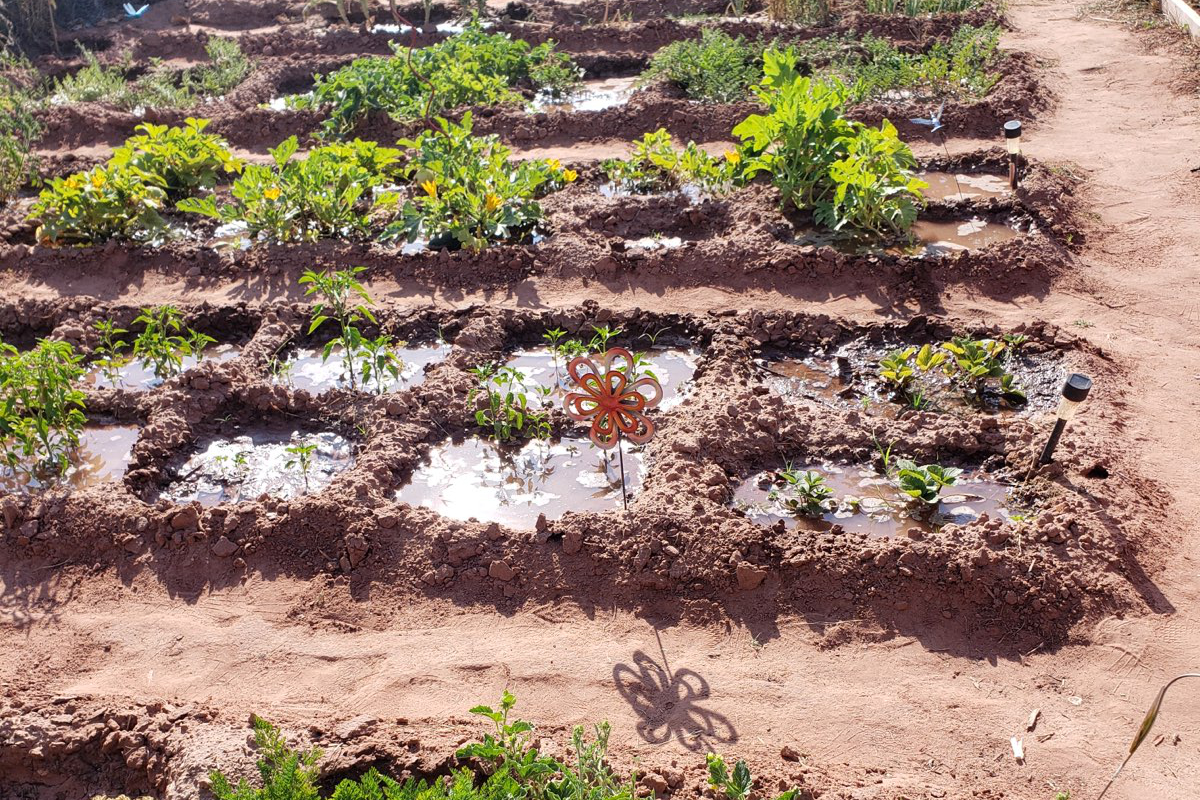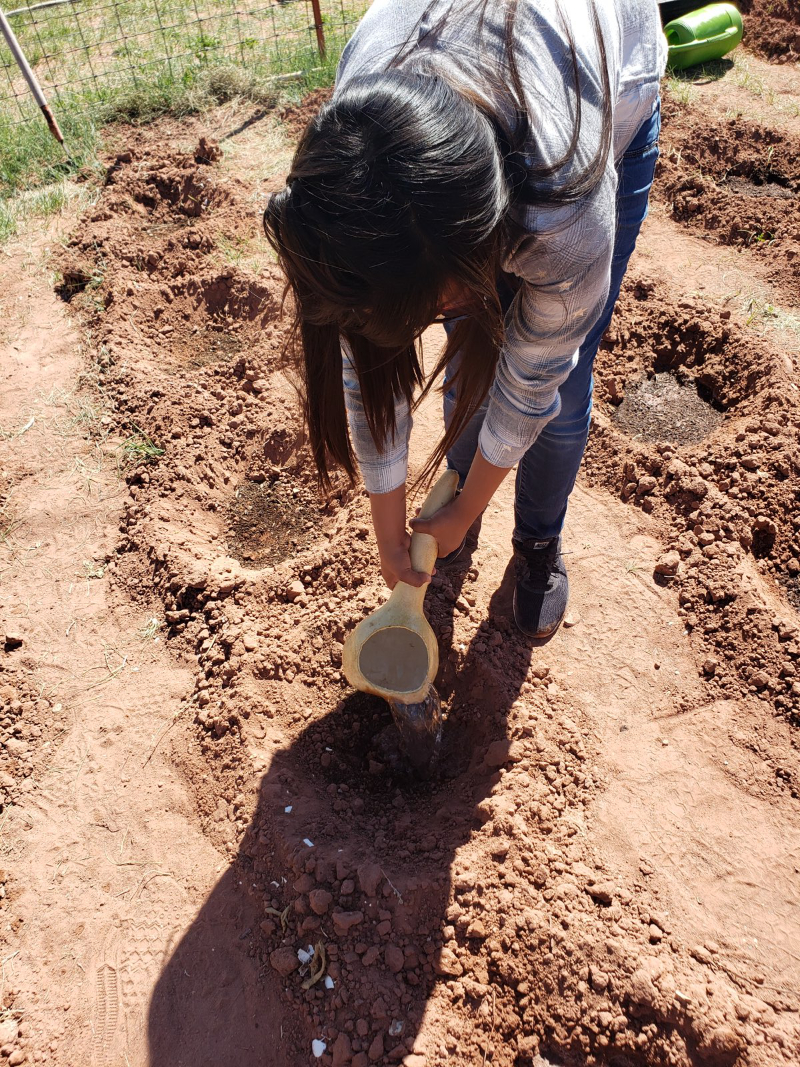In the face of climate change and persistent droughts, a growing number of people from Zuni Pueblo in New Mexico and elsewhere are adopting the traditional farming practice.

In the face of climate change and persistent droughts, a growing number of people from Zuni Pueblo in New Mexico and elsewhere are adopting the traditional farming practice.
October 26, 2021

Curtis Quam’s waffle garden, which he tends with his family. (Courtesy of Curtis Quam)
For the past 64 years, Jim Enote has planted a waffle garden, sunken garden beds enclosed by clay-heavy walls that he learned to build from his grandmother. This year, he planted onions and chiles, which he waters from a nearby stream. It’s an Indigenous farming tradition suited for the semi-arid, high-altitude desert of the Zuni Pueblo in New Mexico, where waffle gardens have long flourished and Enote has farmed since childhood.
“They are the inverse of raised beds, and for an area where it is more arid, they’re actually very efficient at conserving water,” said Enote, who leads the Colorado Plateau Foundation to protect Indigenous land, traditions, and water. Each interior cell of the waffle covers about a square foot of land, just below ground-level, and the raised, mounded earthen walls are designed to help keep moisture in the soil.
Similar sunken beds for growing food with less water have been used globally in arid regions, arising independently by Indigenous farmers, including across distinct Pueblo tribes in the Southwest. “When you have ecological equivalents you often have cultural equivalents,” said Enote. As climate change deepens, he sees this tradition as one of many ways to adapt while building food security and sovereignty.
The Zuni Pueblo’s region is projected to see more intense droughts and storms in the coming years, intensifying the natural weather patterns. “Climate change will basically just make our extremes even more extreme,” said Kirk Bemis, a hydrologist at the Zuni Tribe Conservation Program. “Most channels and rivers around here are ephemeral, or they just vary, and they really depend on storm events.” Zuni agriculture developed in response to these extremes, which makes it especially effective at adapting to the region’s future.
“It’s going to be difficult,” said Enote. “But in the meantime, we still have to do what we can to find ways to adapt and live with it. And I think that the waffle gardens are one tool for us to make it through.”
For a stretch of time, Enote was one of very few people who maintained waffle gardens in the Zuni Pueblo. “In the ‘70s, it reached a point where there weren’t hardly any waffle gardens around,” he said. Enote attributes this largely to the tribe’s move to a cash-labor economy, in the mid-20th century, but this began to shift in the late ‘80s and into the ‘90s with a revival of agricultural traditions.
In recent years, he has observed a growing interest in waffle gardens, among other Zuni farming traditions, especially spurred by economic and social unrest during the pandemic. “There really is a resurgence,” said Enote. “People are having a time of reckoning and soul-searching, and thinking more deeply about our origins, our identity, and that, in truth, we are farmers.”
While many of the larger areas in the Zuni pueblo that used to be farms are no longer utilized, backyard gardens are becoming more common—and a growing number are waffle gardens. Along with engaging in Zuni traditions, Enote says growing food this way “contribute[s] to the household budget,” by supporting food and economic security at the family level.
“I think the future for [the pueblo] and agriculture is in our backyard gardens,” said Daniel Bowannie, an environmental technician who runs the Zuni Sustainable Agriculture Program, which installs gardens and offers technical assistance. The program has installed about 100 modified waffle gardens, using wooden planks instead of clay-soil walls, throughout the village, including at the hospital and senior center. Bowannie also walks people through the process of building their own gardens.
Not long after the pandemic hit, Bowannie’s phone began ringing off the hook. “I started getting calls on my personal phone and people reaching out for other family members or friends that had questions. They were sending me pictures and asking my questions, like: ‘Where do you get the soil?’”
Bowannie’s hope is for every household within the Zuni village to have a backyard garden, and he believes that such a shift could cut a family’s need to shop for groceries in half. “A small, 4-by-8 [foot] garden will get you a good four to five buckets full of corn, which is not enough to completely live off, but enough to feed our families, survive, and carry out our traditions.” He also thinks it’s important for the Zuni people to lessen dependence on grocery stores, which the pandemic showed are vulnerable to supply chain disruptions.
“If we lose grocery stores tomorrow, what are we going to do?” said Bowannie. He sees backyard gardens as an important part of the answer to this question.
Rather than buying soil to fill the program’s box gardens they use a mix that includes soil hauled from the base of hillside trees. “We’re taking the same concepts Zunis used to prepare their field,” said Bowannie. “They would clear the brush and then allow the rainstorms to run off and capture the tree soil and spread it on their fields.” The nutritious, carbon-rich soil helps absorb water, while replacing the need for fertilizer.
Not everyone opts for Bowannie’s box gardens. Curtis Quam, a Zuni museum technician and cultural educator at the A:shiwi A:wan Museum and Heritage Center, decided to go a more traditional route and planted a waffle garden with clay-soil walls with his family in 2017. This year, he planted onions, tomatoes, cucumbers, zucchini, yellow crookneck squash, basil, jalapeño, and carrots in the garden.
“I wanted to have something traditional, and plant straight in the ground, and share that experience with my family,” said Quam, who plants his thirstiest plants within deeper depressions. “It goes to supplementing [food] for my family, and if we’re lucky to have a good and bountiful harvest, we share that with community members.”
Along with these benefits, Quam has noticed that reconnecting with this tradition helps preserve the Zuni language. “Sometimes you can’t help but speak your Zuni or native language within the garden area because that’s how you learned from your grandparents,” he said.
Gary Nabhan, an agrarian activist and ethnobotanist based in Arizona, has observed waffle gardens in Egypt and the Canary Islands with trees that offer shade to underlying vegetables and vines extending beyond the beds. He sees the broader “very sound ecological principles” of the gardens as widely effective in arid landscapes, though cautions against replicating a specific tradition outside its original climate.
“People have already independently invented this in multiple places, so you really have to localize its size, the water source and type of soil. That’s already happened all over arid lands around the world,” said Nabhan.
That includes the area directly east of the Zuni Pueblo. In the el Valle region of New Mexico, Yvonne Sandoval, who describes herself as “mixed-race Indigenous,” tends to a 20-square-foot square waffle garden. It’s part of the Bueno Para Todos Cooperative, a small farm predominately led by queer farmers of color, as a way to reconnect with Indigenous methods for farming on dry, arid land and feed the surrounding community.

Curtis Quam’s 13-year old daughter Amarii watering the family’s waffle garden with a gourd. (Photo courtesy of Curtis Quam)
“In this region, we have really high winds and the air can be really dry, so waffle bed gardens are ideal,” said Sandoval. “I want it to be an example that shows pre-colonial farming methods can still be an answer to climate change.”
This summer, the waffle garden brimmed with corn, squash, amaranth, chilies, several varieties of peas, carrots, tomatoes, and herbs, which was fed entirely by rainwater captured in cisterns and the waffle garden’s sunken beds. This catchment system has enabled Sandoval to reduce her dependence on the acequia, the centuries-old irrigation canals that are at risk of running dry.
Of course, even the most effective agricultural methods for conserving water are only one piece of the solution. Protecting natural resources, sacred places, and Indigenous languages that carry agricultural knowledge, explains Jim Enote, are also vital for surviving the future of ongoing climate change and biodiversity loss.
“Whether it’s small streams, even springs, they need to be protected because those are always our fallback if modern water delivery systems fail,” says Enote. After all, you only need a spring or cistern to sustain a waffle garden.

October 9, 2024
In this week’s Field Report, MAHA lands on Capitol Hill, climate-friendly farm funding, and more.
October 2, 2024

October 2, 2024

October 1, 2024

September 30, 2024

September 25, 2024

September 25, 2024

Ivan Kinsman, Executive Director, Rainwater Runoff